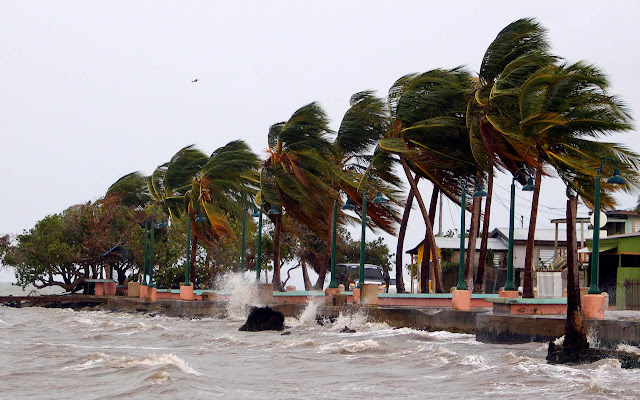Hurricane Maria has made landfall in Puerto Rico, bringing "disastrous" 155mph breezes and dangerous storm surges , after battering the Virgin Islands.
The "Monster" storm started lashing the US Virgin Island of St Croix early on Wednesday, as it kept on cutting a savage north-westerly way through the Caribbean.
After warnings Maria could destroy Puerto Rico, the US territory's 3.5 million inhabitants were urged to seek shelter in the midst of fears substantial rain could cause landslides and storm surges of up to 9ft could swamp low-lying zones.
The second maximum-strength storm to sweep through the Atlantic this month has just killed no less than eight individuals - one individual on Guadeloupe and seven individuals on the island of Dominica, where 90 percent of buildings are supposedly destroyed. Details of damage are limited because of communications being down.
Authorities in Puerto Rico - a safe house for individuals escaping other storm-hit Caribbean islands in earlier weeks - additionally fear trash left by Hurricane Irma could prove dangerous during Maria's winds.
Governer Ricardo Rossello depicted Maria as "the worst strom of the last century" and US President Donald Trump portrayed it as a "monster", including: "Our hearts are with you."
Maria had maximum sustained winds of 90mph as its external eyewall lashed the US Virgin Island of St Croix at 6am BST on Wednesday before moving west.
Portraying the storm as "potentially catastrophic", the US National Hurricane Center said: "Some fluctuations in intensity are likely during the next day or two, but Maria is forecast to remain an extremely dangerous category four or five hurricane until it moves near or over the Virgin Islands and Puerto Rico."
The storm is following a similar path to Irma, a standout amongst the most strongest in decades, and relief workers hustled to secure loose debris that can possibly make Maria more dangerous if got by high winds.
Damage on the British Virgin Islands is unclear after Maria skirted past at an early stage Wednesday.
"Our islands are extremely vulnerable right now," the region's chief Orlando Smith said in an announcement, cautioning that the storm could turn debris left by Irma into dangerous projectiles.
A hurricane warning was also set up for Montserrat, with a hurricane watch connected to Anguilla and the Turks and Caicos islands.
In the wake of intersection Puerto Rico, Maria is due to pass north of the upper east coast of the Dominican Republic on Wednesday night and Thursday.
Maria comes days after the area was hit by Hurricane Irma, which positioned as a standout amongst the most powerful Atlantic storm on record and left a trail of devastation on a few Caribbean islands.
The "Monster" storm started lashing the US Virgin Island of St Croix early on Wednesday, as it kept on cutting a savage north-westerly way through the Caribbean.
After warnings Maria could destroy Puerto Rico, the US territory's 3.5 million inhabitants were urged to seek shelter in the midst of fears substantial rain could cause landslides and storm surges of up to 9ft could swamp low-lying zones.
The second maximum-strength storm to sweep through the Atlantic this month has just killed no less than eight individuals - one individual on Guadeloupe and seven individuals on the island of Dominica, where 90 percent of buildings are supposedly destroyed. Details of damage are limited because of communications being down.
Authorities in Puerto Rico - a safe house for individuals escaping other storm-hit Caribbean islands in earlier weeks - additionally fear trash left by Hurricane Irma could prove dangerous during Maria's winds.
Governer Ricardo Rossello depicted Maria as "the worst strom of the last century" and US President Donald Trump portrayed it as a "monster", including: "Our hearts are with you."
Maria had maximum sustained winds of 90mph as its external eyewall lashed the US Virgin Island of St Croix at 6am BST on Wednesday before moving west.
Portraying the storm as "potentially catastrophic", the US National Hurricane Center said: "Some fluctuations in intensity are likely during the next day or two, but Maria is forecast to remain an extremely dangerous category four or five hurricane until it moves near or over the Virgin Islands and Puerto Rico."
The storm is following a similar path to Irma, a standout amongst the most strongest in decades, and relief workers hustled to secure loose debris that can possibly make Maria more dangerous if got by high winds.
Damage on the British Virgin Islands is unclear after Maria skirted past at an early stage Wednesday.
"Our islands are extremely vulnerable right now," the region's chief Orlando Smith said in an announcement, cautioning that the storm could turn debris left by Irma into dangerous projectiles.
A hurricane warning was also set up for Montserrat, with a hurricane watch connected to Anguilla and the Turks and Caicos islands.
In the wake of intersection Puerto Rico, Maria is due to pass north of the upper east coast of the Dominican Republic on Wednesday night and Thursday.
Maria comes days after the area was hit by Hurricane Irma, which positioned as a standout amongst the most powerful Atlantic storm on record and left a trail of devastation on a few Caribbean islands.



Comments
Post a Comment